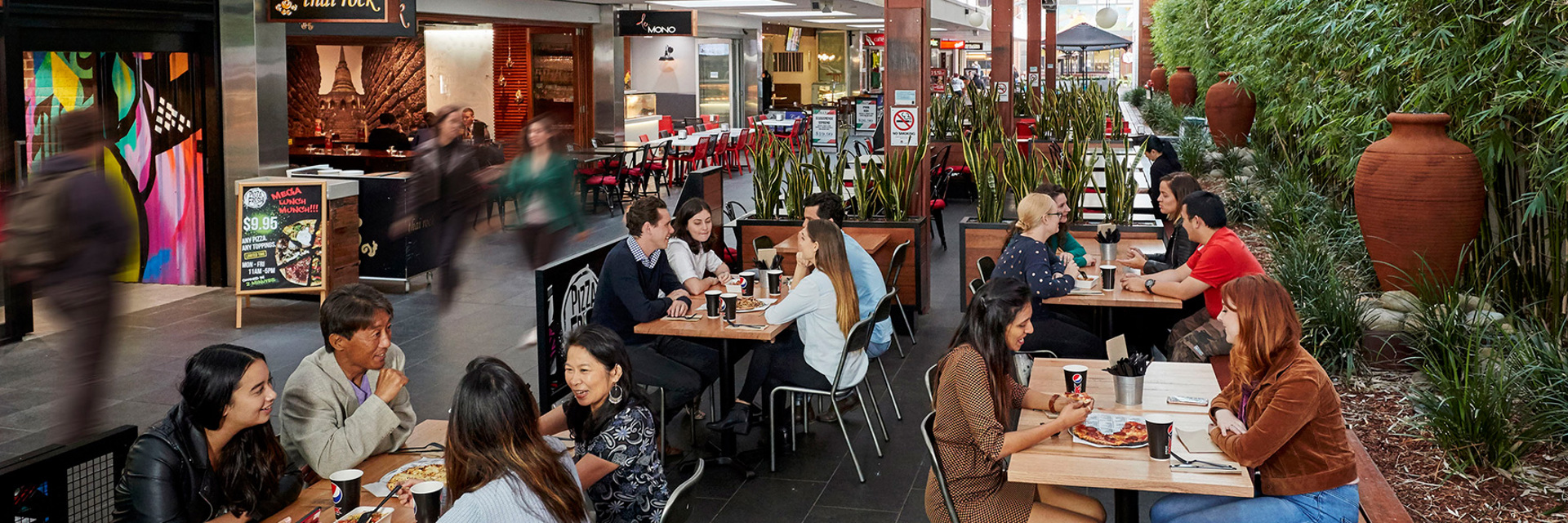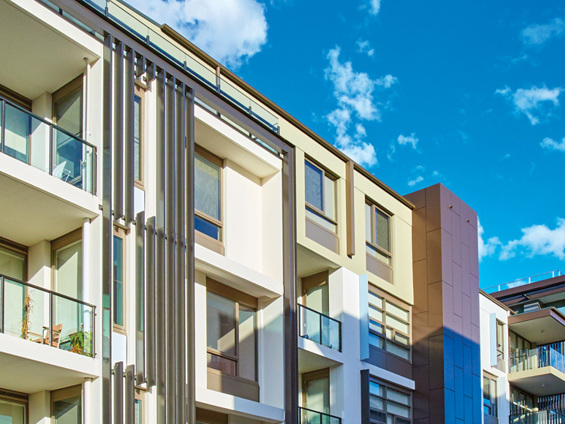Stockland delivers another strong performance for FY17
Financial results for the year ended 30 June 2017
- Statutory profit of $1,195 million, up 34.4% on FY16
- Funds From Operations (FFO 1 ) of $802 million, up 8.5% on FY16
- FFO per security of 33.4 cents, up 7.4% on FY16
- Adjusted Funds From Operations (AFFO 1 ) of $687m, up 10.3% on FY16
- AFFO per security of 28.6 cents, up 8.7% on FY16
- Growth in all core businesses, with Residential operating profit up 17.4% on FY16
- Return On Equity (ROE) of 11.4%, up 0.4 percentage points on FY16
- Net Tangible Assets (NTA) per security of $4.04, up 5.8%
- Distribution Per Security (DPS) of 25.5 cents, up 4.1% from FY16.
Targets for FY18
- Targeting growth in FFO per security of 5.0-6.5%, assuming no material change in market conditions
- Targeting an estimated DPS of 26.5 cents, a 4% increase on FY17, assuming no material change in market conditions.
Stockland Managing Director and CEO Mark Steinert today announced a strong performance for the group for FY17, with FFO up 8.5% to $802 million.
Mr Steinert said: “We’ve delivered another positive performance this financial year across our diversified business, by reinforcing our position as the leading creator of communities in Australia, strategically repositioning our assets and restocking the portfolio.
“All of our businesses contributed to this result. Our Residential and Retirement Living businesses achieved record results, and Commercial Property delivered a good performance across the different asset classes, despite challenging conditions in the retail market.
“We continue to see the benefits of a disciplined approach to implementing our strategy – to grow our asset returns, provide great customer experiences, deliver operational excellence and improve our capital strength.
“Our customers provide the foundation of our success, with an average customer satisfaction score across our business of 82%.
“Our Residential business delivered record growth again this year, due to new projects commencing, above forecast sales results, strategic acquisitions and positive market conditions.
“We have maintained our position as Australia’s leading creator of new communities, settling 6,604 lots over the reporting period, with over 50% of net deposits from first home buyers. We’ve also diversified our residential business through medium density development. We remain well placed in the current lending environment with 75% of our sales to owner occupiers and ongoing positive market conditions.
“Our Retirement Living business delivered its fourth consecutive year of double-digit growth. This is underpinned by a dedicated focus on customer service, open and respectful communication and resident satisfaction. We are progressing our redevelopment pipeline to provide the highest quality retirement living options for our residents.
“Our NTA per security increased by 5.8% to $4.04, with income growth and a tightening in capitalisation rates on our Commercial Property portfolio from 6.4% to 6.2%.
“Our shopping centres are the heart of the communities they serve, and are the town centres of the future. Our diversified business model enables us to leverage community creation through our centres, which we continue to enhance by providing lifestyle, food, service, entertainment and leisure precincts to improve customer experience.
“Once again, we were recognised as a global leader for our sustainability credentials and I’m proud to lead a company that is committed to achieving excellence in this space,” Mr Steinert said.
Stockland was named the S&P Dow Jones Sustainability Indices (DJSI) Global Real Estate Sector Leader for the second consecutive year and achieved Global Sector and Regional Sector Leader status in the 2016 Global Real Estate Sustainability Benchmark (GRESB) survey in the category Diversified - Retail/Office. We were also recognised by CDP with a position on the Climate A List.
Financial management
Gearing: 22.7%
Weighted average debt maturity: 5.7 years
Credit rating: A-/stable
Chief Financial Officer Tiernan O’Rourke said: “Our focus on maintaining a strong balance sheet has underpinned this result and sets a good platform for future growth.
“A commitment to actively managing our debt program has seen us improve our weighted average cost of debt, which has fallen from 5.8% in FY16, to 5.4% in FY17, and increase our weighted average debt maturity to 5.7 years,” Mr O’Rourke said.
“Gearing at the end of FY17 was 22.7%, at the lower end of our 20-30% target range, due to disciplined capital management and higher operating cash flows.
“Stockland has retained an A/-stable credit rating from Standard and Poor’s and in August 2017, also obtained a second rating from Moody’s of A3. This confirms the strength of our balance sheet and provides access to a broader range of debt markets, positioning the business well to continue to grow in the future.
“We are continuing to implement new SAP systems, which will improve efficiencies across our business,” Mr O’Rourke said.
Retail portfolio highlights
Funds from Operations (FFO): $419 million (FY16: $402 million)
Group Executive and CEO Commercial Property John Schroder, said: “In a challenging environment, we’ve delivered positive FFO growth of 4.1%, maintained high occupancy and continued to focus on remixing our portfolio in line with our customer needs and trade area dynamics.
“Nationally, retail sales in the past year have been impacted by low wages growth, some retailer closures, and mixed results from major tenants. While trading at some centres has been variable, we’ve seen an improvement in sales growth in the second half and particularly in the final quarter. Specialty store sales productivity grew 1.9% to $9,072 per square metre, which exceeds the Urbis sub-regional average of $8,376 per square metre by 8.3%.
“We continue to see growth in lifestyle and entertainment tenancies, particularly larger format operators such as JB Hi-Fi, Hoyts and Harris Scarfe, and we’ve recently confirmed that H&M will open new stores at our Townsville and Rockhampton centres. Growth in specialty retail sales of 9.7% in retail services and 5.3% in casual dining and food catering over FY17 reflects the success of our remixing strategy. We also continue to look at ways to introduce technology to enhance our customers experience across our centres.
“Momentum continued in the delivery of the retail development pipeline, with the $412 million transformation of Stockland Green Hills at East Maitland progressing on schedule, and a $37 million redevelopment underway at Stockland Wendouree in Ballarat,” Mr Schroder said.
Stockland has a future retail development pipeline of $1 billion, with three Development Agreements already in place. The company is targeting stabilised FFO yields of 7%+, and incremental Internal Rates of Return (IRR) of 9%+ from this activity.
Logistics and Business Parks portfolio highlights
FFO: $143 million (FY16: $132 million)
John Schroder said: “Our Logistics and Business Parks business had an outstanding year. Occupancy has increased to 99% following a period of active leasing and renewals, and the portfolio now represents 15% of our total assets.
“We achieved strong comparable FFO growth of 3.6% with positive leasing results, particularly in the Sydney market.
“Our development pipeline is also progressing well, with recent redevelopments at Ingleburn (Sydney), Erskine Park (Sydney) and Oakleigh (Melbourne) all completed on budget and fully leased. A $77 million development project is underway at Warwick Farm (Sydney), which is majority pre-leased to Daikin, for a 10 year term. Pleasingly, the future pipeline also looks very positive,” Mr Schroder said.
Office portfolio highlights
FFO: $59 million (FY16: $68 million)
John Schroder said: “We achieved solid comparable FFO growth of 2.3%. Our Sydney office portfolio performed well this year, which represents the majority of our office assets. The Perth and Canberra markets remain challenging, but we are seeing positive leasing momentum at our assets. Several of our Sydney properties also have development opportunities,” Mr Schroder said.
Residential business highlights
Operating Profit: $270 million (FY16: $230 million)
Group Executive and CEO Residential Andrew Whitson said: “Our Residential business delivered another year of double digit growth, with operating profit growth of 17.4%, and a net operating profit margin of 16.6% on the core portfolio. We settled a record 6,604 lots in FY17, and we commence FY18 with record pre-sales.
“We have made a number of strategic land acquisitions over the past 12 months to significantly restock our portfolio, acquiring 9,900 lots. The majority of these are in the high-performing Melbourne market and our land bank now totals over 80,000 future housing lots nationally.
“We continued to expand our medium density business, with 213 homes settled this year, almost 600 currently under construction and a pipeline of over 2,800 across Australia. Medium density development is a key growth driver for our residential business as we extend our focus on community creation in the important ‘missing middle’ of our major capital cities.
“We continue to take a leadership position in housing affordability and are delivering some of the most liveable and desirable new communities in Australia. Our commitment to delivering a range of options for first home buyers and families places us in a preferred position for residential lending trends and government growth initiatives,” Mr Whitson said.
Retirement Living business highlights
Operating Profit: $63 million (FY16: $57 million)
Operating profit in Retirement Living was up 11.1% on FY16, reflecting strong sales, active management of our portfolio and improved margins. Cash ROA increased to 6.2%, from 5.8% in FY16.
Group Executive and CEO Retirement Living Stephen Bull said: “This is the fourth consecutive year of double-digit growth for our business, driven by our focus on resident satisfaction and underpinned by a customer-centric culture.
“Our development pipeline is proceeding well, with the delivery of our UDIA award-winning apartments at Cardinal Freeman The Residences in Sydney’s inner-west. We are also making good progress on our new vertical village at Birtinya, in the heart of the Sunshine Coast’s new health hub.
"We continue to invest in new projects, with planning underway on a number of brownfield redevelopments at existing villages,” Mr Bull said.
“Development margins were high this year at 19.1%, due to project delivery mix, but will normalise in FY18 to around 15-17%.
“We are further extending our reputation for creating quality villages, and broadening our customer reach through new non-deferred management fee communities for over 55s, called ‘Aspire’. We have two projects in this new category currently underway, at our Elara residential community in Sydney and Calleya in Perth, and the initiative will be rolled out at other locations over the coming years.”
Mr Bull also reinforced Stockland’s commitment to creating the highest quality retirement villages in Australia.
“We understand there is a lot of focus on the sector at the moment. We take pride in our retirement living business, and are committed to open, transparent and respectful relationships with our residents. Every year, we engage independent consultants to assess resident satisfaction. Last year more than 6,800 residents participated in the survey, and rated their overall satisfaction with Stockland at 8.4 out of 10,” Mr Bull said.
Outlook
Mr Steinert said: “Our results have been driven by our ongoing commitment to delivering the best communities and vibrant town centres across the country.
“We’ve continued to focus on strategically repositioning our assets and enhancing the customer experience across our diversified portfolio. A disciplined approach to acquisitions and focus on creating the most liveable and connected communities will set us up well for the future.
“In the year ahead, we expect positive economic conditions to continue, and interest rates to remain fairly stable. We commence the financial year well placed to meet our goals of sustainable profit growth on a through-the-cycle basis, with strong occupancy and pre-sales.
“Our Commercial Property business should maintain moderate growth in returns, with comparable FFO growth of 2-3% including comparable retail FFO growth of around 3%. We will continue to invest, grow and remix our portfolio, increasing our focus on convenient and desirable town centres, with selected divestments funding much of this activity.
“In the coming year, we expect residential settlements to again exceed 6,000 lots, including around 350 medium density homes. While lending conditions to investors and foreign buyers are tightening, owner occupiers remain our core focus and represent 75% of our net residential sales, with less than 3% of the total to buyers requiring Foreign Investment Review Board approval.
“While current regulatory settings are likely to lead to some moderation in growth rates for residential property prices, we continue to expect an elongated cycle for the east coast markets. We enter FY18 in a position of leadership in housing affordability with strong pre-sales.
“Our Retirement Living business will continue to grow profits in FY18, but at a more moderate level due to the timing of development completions,” Mr Steinert said.
We expect FY18 FFO growth to be slightly lower than FY17, primarily due to non-Sydney office let-up assumptions, higher Commercial Property outgoings, particularly electricity prices, and lower Retirement Living development profit reflecting project timing.
Assuming no material change in market conditions, we are targeting growth in FFO per security of 5.0-6.5% in FY18, with growth skewed to the first half due to timing of residential settlements, with distribution per security growth targeted at 4%, representing 26.5 cents per security.
Stockland’s FY17 results presentation will be webcast via www.stockland.com.au on Wednesday 16 August 2017 at 11.30am (AEST).
Stockland FY17 Results: Key metrics
| FY17 | FY16 | Change | |
|---|---|---|---|
| Statutory Profit | $1,195m | $889m | 34.4% |
| Statutory Earnings per security | 49.8 cents | 37.4 cents | 33.2% |
| Funds from Operations (FFO) 1 | $802m | $740m | 8.5% |
| FFO per security | 33.4 cents | 31.1 cents | 7.4% |
| AFFO per security | 28.6 cents | 26.3 cents | 8.7% |
| Distribution per security | 25.5 cents | 24.5 cents | 4.1% |
| Net Tangible Assets per security | $4.04 | $3.82 | 5.8% |
| Gearing (D/TTA) | 22.7% | 23.8% | |
| Return on Equity (ROE) 2 | 11.4% | 11.0% |
1 FFO is considered the most meaningful measure of underlying and recurring earnings. FFO and AFFO are determined with reference to PCA guidelines.
2 Return on Equity accumulates individual and business Return on Assets and adjusted for cash interest paid and average drawn debt for the 12 month period. Excludes residential community workout projects.


